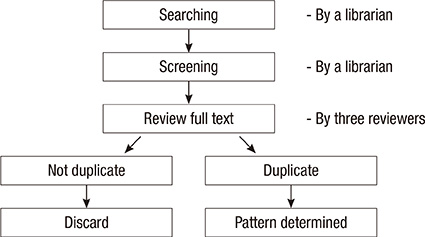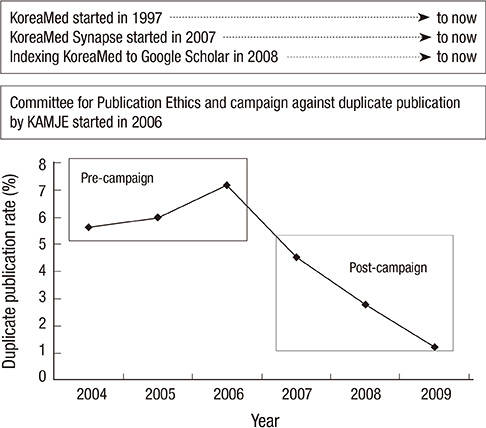J Korean Med Sci.
2014 Feb;29(2):172-175. 10.3346/jkms.2014.29.2.172.
Duplicate Publication Rate Decline in Korean Medical Journals
- Affiliations
-
- 1Department of Family Medicine, Kandong Sacred Hospital, Hallym University College of Medicine, Seoul, Korea.
- 2Department of Pediatrics, Kyung Hee University School of Medicine, Seoul, Korea. baecw@khnmc.or.kr
- 3Health Promotion Center, Chung-Ang University Hospital, Seoul, Korea.
- 4Infolumi Co., Seongnam, Korea.
- KMID: 1789971
- DOI: http://doi.org/10.3346/jkms.2014.29.2.172
Abstract
- The purpose of this study was to examine trends in duplicate publication in Korean medical articles indexed in the KoreaMed database from 2004 to 2009, before and after a campaign against scientific misconduct launched by the Korean Association of Medical Journal Editors in 2006. The study covered period from 2007 to 2012; and 5% of the articles indexed in KoreaMed were retrieved by random sampling. Three authors reviewed full texts of the retrieved articles. The pattern of duplicate publication, such as copy, salami slicing (fragmentation), and aggregation (imalas), was also determined. Before the launching ethics campaign, the national duplication rate in medical journals was relatively high: 5.9% in 2004, 6.0% in 2005, and 7.2% in 2006. However, duplication rate steadily declined to 4.5% in 2007, 2.8% in 2008, and 1.2 % in 2009. Of all duplicated articles, 53.4% were classified as copies, 27.8% as salami slicing, and 18.8% as aggregation (imalas). The decline in duplicate publication rate took place as a result of nationwide campaigns and monitoring by KoreaMed and KoreaMed Synapse, starting from 2006.
MeSH Terms
Figure
Cited by 1 articles
-
Impacts of the Journal Evaluation Program of the Korean Association of Medical Journal Editors (KAMJE) on the Quality of the Member Journals
Hee-Jin Yang, Se Jeong Oh, Sung-Tae Hong
J Korean Med Sci. 2018;33(48):. doi: 10.3346/jkms.2018.33.e305.
Reference
-
1. International Committee of Medical Journal Editors. Recommendations for the conduct, reporting, editing, and publication of scholarly work in medical journals. accessed on 19 December 2013. Available at http://www.icmje.org/publishing_d.html.2. Cho BK, Rosenfeldt F, Turina MI, Karp RB, Ferguson TB, Bodnar E, Waldhausen JA. Joint statement on redundant (duplicate) publication by the editors of the undersigned cardiothoracic journals. Ann Thorac Surg. 2000; 69:663.3. Kim SY. Double submission, double publication. Korean J Fam Med. 2012; 33:69.4. Blancett SS, Flanagin A, Young RK. Duplicate publication in the nursing literature. Image J Nurs Sch. 1995; 27:51–56.5. Mojon-Azzi SM, Jiang X, Wagner U, Mojon DS. Redundant publications in scientific ophthalmologic journals: the tip of the iceberg? Ophthalmology. 2004; 111:863–866.6. Rosenthal EL, Masdon JL, Buckman C, Hawn M. Duplicate publications in the otolaryngology literature. Laryngoscope. 2003; 113:772–774.7. Chennagiri RJ, Critchley P, Giele H. Duplicate publication in the Journal of Hand Surgery. J Hand Surg Br. 2004; 29:625–628.8. Barnard H, Overbeke AJ. Duplicate publication of original manuscripts in and from the Nederlands Tijdschrift voor Geneeskunde. Ned Tijdschr Geneeskd. 1993; 137:593–597.9. Arrivé L, Lewin M, Dono P, Monnier-Cholley L, Hoeffel C, Tubiana JM. Redundant publication in the journal Radiology. Radiology. 2008; 247:836–840.10. Cheung VW, Lam GO, Wang YF, Chadha NK. Current incidence of duplicate publication in otolaryngology. Laryngoscope. 2013; doi: 10.1002/lary.24294.11. Tramèr MR, Reynolds DJ, Moore RA, McQuay HJ. Impact of covert duplicate publication on meta-analysis: a case study. BMJ. 1997; 315:635–640.12. Von Elm E, Poglia G, Walder B, Tramèr MR. Different patterns of duplicate publication: an analysis of articles used in systematic reviews. JAMA. 2004; 291:974–980.13. Steen RG, Casadevall A, Fang FC. Why has the number of scientific retractions increased? PLoS One. 2013; 8:e68397.14. Kim SY, Hahm CK, Bae CW, Cho HM. Duplicate publications in Korean medical journals indexed in KoreaMed. J Korean Med Sci. 2008; 23:131–133.15. Suh CO, Oh SJ, Hong ST. Korean Association of Medical Journal Editors at the forefront of improving the quality and indexing chances of its member journals. J Korean Med Sci. 2013; 28:648–650.16. Korean Association of Medical Journal Editors. Good publication practice guidelines for medical journals. 2nd ed. Seoul: Academya;2013. p. 1–118.17. Bae CW, Kim SY, Huh S, Hahm CK. Sample cases of duplicate publication. Seoul: Xmlarchive;2011. p. 1–116.
- Full Text Links
- Actions
-
Cited
- CITED
-
- Close
- Share
- Similar articles
-
- Ethical Issues of Multiple Publication
- Duplicate Publications in Korean Medical Journals Indexed in KoreaMed
- Publication Delay of Korean Medical Journals
- Chemical colitis caused by hydrogen peroxide enema in a child: case report and literature review
- Open Access Publishing in India: Coverage, Relevance, and Future Perspectives



